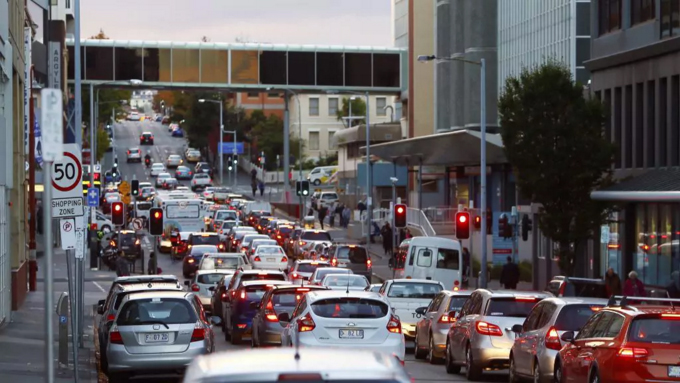We cannot have a liveable city if we fail to address the car problem.

Traffic in Argyle Street blocking exit from adjacent council carpark for five hours, April 2018. PHOTO Matt Thomson/Mercury
What distinguishes ordinary cities from extraordinary ones, “liveable” cities from urban wastelands? What things, added together, make a fully-functioning city?
These questions are as relevant now as they were in 1961, when a passionate young New Yorker named Jane Jacobs wrote The Death and Life of Great American Cities, about how bad road planning was destroying local neighbourhoods and sucking the life out of metropolitan America.
The same questions are informing the City of Hobart’s new transport strategy, which asks, among other things, how do we shape our city to make it a better place to be – not just easier to get about but also more stimulating, more attractive, more peaceful, more secure?
Thinking about transport, most people will home in on ease of movement, and in particular on motor traffic – cars on roads and how we keep them moving. But as the strategy makes clear, it simply isn’t feasible to consider any sort of transport in isolation
For most of the 10,000-year story of cities nearly everyone walked, with a few sitting on beasts of burden and then in carts and carriages. It was a natural part of interpersonal contact, which was what city life was all about.
It still is, as the Hobart transport strategy recognises. Private car use encourages separation and territorial rights. Interpersonal contact between car users is rare, except in cases of road rage.
The kinds of cities we yearn for – about people meeting for business, pleasure and stimulation – do not need private cars. If we want Hobart to be a “liveable” city, we have to keep cars at bay.
Cars are the least space-efficient form of transport, as Elliot Fishman of Melbourne’s Institute for Sensible Transport told a Climate Tasmania seminar in Hobart this month. In growing cities, more roads mean more cars. Far from being the answer to traffic congestion, they just make it worse.
Motor transport is an issue for another important reason: it is Tasmania’s biggest source of greenhouse emissions. Per person-kilometre, based on average occupancy, a car releases over 13 times as much carbon dioxide as a bus, and infinitely more than walking or cycling.
The strategy informs us that Hobart city is Tasmania’s biggest work destination, containing more than half Greater Hobart jobs and over 40 per cent of southern Tasmania’s. Most commuters are heading for the city, so a new bypass road would make little difference to peak hour traffic.
In 2011 a state government survey of people working in the city found that 79 per cent travelled to and from work in cars (68 per cent as driver, 11 per cent as passenger). Of people living within the boundary of the city proper, 61 per cent travelled in cars.
Countering that, 25 per cent of commuters living within the city boundary walked to work – the highest proportion of walking commuters in all Australian capitals including Canberra.
Less welcome is the data on cycling (just two per cent of commuters from Greater Hobart) and users of buses, a measly eight per cent. Electric bikes may have helped lift the cycling figure, but as a bus user I’m not confident that Metro usage would be much higher today.
That’s a concern, because as the draft strategy makes clear, buses and bicycles are the main alternatives to cars in a metropolitan area as stretched out as Hobart – and on an island where cutting transport emissions should be the top climate policy priority.
Work and school-related journeys, tailor-made for public transport, are responsible for most travel into or through the city. So fully-functioning, well-utilised public transport – mainly bus but also potentially light rail and ferries – is key to keeping Hobart on the move.
Reducing car usage in Hobart is no simple proposition. I enjoy the company of people I don’t know when I use buses, but I accept that’s not everyone’s cup of tea. And regardless of the health benefits of walking to a bus stop, most people would opt for the car a few steps from the front door.
Making non-car city transit more appealing is well beyond local government’s means. Advertisers spend billions equating freedom and happiness with shiny new cars on shiny new roads. Little wonder that MPs continue to see road-building as the path to electoral success.
But imagine if higher levels of government gave funding priority for city transit infrastructure not to new bypass roads, but to public transport priority lanes and pedestrian and cycle paths.
Imagine well-appointed, federally-funded public transport hubs at key points in Hobart suburbs, where people using bus, light rail or ferry could drive their car to a free all-day parking station integrated into a transit depot, allowing them to transfer rapidly in comfort and shelter.
A city flourishes not because of property booms, but because its citizens find it easy to live there and get about. A federal government that stops ignoring public transport and funds this generational transition won’t just transform our cities. It will have earned a place in history.
The Hobart transport strategy is up for public discussion at various city venues this week. For information about a forum in your area, google City of Hobart transport strategy 2018-30.
